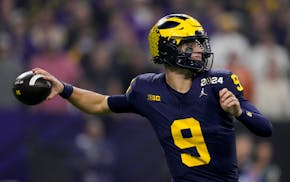FORT MYERS, FLA. – When he played for Toronto, Paul Molitor put the M in WAMCO. Blue Jays manager Cito Gaston liked his set lineup of Devon White, Robbie Alomar, Molitor, Joe Carter and John Olerud, the heart of the team that won the 1993 World Series.
During that season, the Jays traded for Rickey Henderson, the greatest leadoff hitter in baseball history. HWAMCO does not have a ring to it, and Gaston wanted to include his star players in whatever lineup changes would be necessary, so he called his top five hitters into his office, handed them sheets of paper and asked them to write out their ideal lineups.
Henderson wound up leading off.
Last year, when the Twins called up top prospect and exceptionally fast runner Byron Buxton during the season, Molitor, the Twins rookie manager, remembered Gaston's inclusiveness, and called his veteran hitters into his office. He asked them to write down their ideal lineups, wondering how many of them would bat Buxton leadoff.
"Brian Dozier listed himself as the leadoff hitter, and Joe Mauer had himself hitting third, whether against lefties or righties," Molitor said Monday. "That's just how they see themselves."
What's interesting is that Molitor doesn't necessarily agree, and might be willing to take Mauer out of the third spot in the lineup, where he has batted nearly his entire life.
"No, I'm not locked into Joe at 3," Molitor said.
Last year, the Twins finished eighth of 15 American League teams in runs scored, even though they ranked 13th in on-base-plus-slugging percentage (OPS). Once again, they have an intriguing collection of hitters but few lineup prototypes.
Dozier likes to lead off but has led the team in home runs for three consecutive seasons. His on-base percentage of .307 is not conducive to leading off, and his low batting average is not conducive to hitting second or third.
Mauer likes to bat third but his slugging percentage of .380 was the eighth best among Twins regulars. On a quality offensive team he might be best suited to hitting eighth or ninth.
Miguel Sano is the team's best and most dangerous batter, but strikes out more than prototypical No. 3 hitters.
"Can we hit Miguel third? Yes," Molitor said. "Can he hit fourth? Yes. Can Joe hit second? Yes. I still haven't really thought about Joe leading off. I know a lot of people like to ask me about that because on-base percentage is still an area where he's one of the best guys on the team, even though his batting average hasn't been what we saw as a younger player.
"He's still a top-of-the-lineup guy. I'm just not sure where yet."
The Twins don't have prototypes for the first, third and fifth spots in their lineup, at least not until Buxton becomes polished enough to bat leadoff.
I think Molitor will keep Dozier in the leadoff spot and bat Mauer second. While their offensive profiles might suggest batting Mauer first and Dozier second, that would leave the Twins with a stretch of righthanded hitters that could be victimized by strong righthanded pitching.
Here's my ideal lineup, at least until Buxton matures: Dozier, Mauer, Sano, Trevor Plouffe, Byung Ho Park/Oswaldo Arcia, Eddie Rosario, Eduardo Escobar, Kurt Suzuki/John Ryan Murphy, Buxton.
This possible lineup highlights the importance of Buxton. If he can produce as a leadoff hitter, the lineup would become much deeper, with much more speed at the top.
At the moment, the Twins have only one everyday player who should be clearly better offensively than the league average: Sano.
Dozier's power obscures his low on-base percentage and batting average. He finished last season with an OPS of .751. Robinson Cano, considered a disappointment for Seattle, had an OPS of .779.
To perpetuate a theme, the Twins will be a good offensive team when Sano and Buxton make them a good offensive team. Molitor's lineup decisions will become much simpler when Buxton proves he can hit big-league pitching.
Jim Souhan's podcast can be heard at MalePatternPodcasts.com. On Twitter: @SouhanStrib. • jsouhan@startribune.com

Souhan: Wolves fans made Game 1 special. Now bring on Game 2.

Souhan: Should Vikings even consider McCarthy in NFL draft?

Souhan: NAW erases Suns' lead, Game 1 advantage with big performance

Souhan: This is KAT's chance to prove Flip Saunders was right


![Minnesota Twins pitcher Fernando Abad (58) during a first base drill. ] CARLOS GONZALEZ cgonzalez@startribune.com - February 22, 2016, Fort Myers, FL,](https://arc.stimg.co/startribunemedia/BOVDIOMZMHXUAZV6TDTOWSW5PY.jpg?w=600&h=600&auto=format%2Ccompress&cs=tinysrgb)